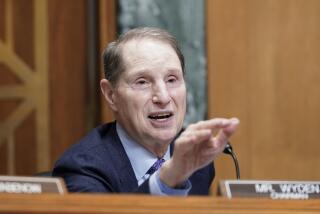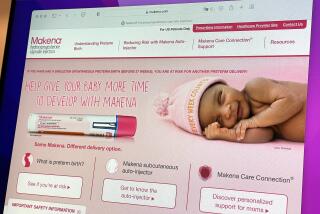Desire, Caution Will Collide at Breast Implant Hearings
WASHINGTON — In Mary McDonough’s ideal world, the one she encourages her 11-year-old daughter to help create, women wouldn’t want to change the size of their breasts. They would simply “respect the bodies God gave them.”
But in the real world -- light-years away from “The Waltons,” the 1970s TV drama that gave the actress and filmmaker her start -- women’s demand for bigger breasts is stronger than ever.
In the last 40 years, as many as 2.5 million women in the United States have received breast implants, 80% of them for cosmetic reasons. In 1992, the U.S. Food and Drug Administration, concerned about reports of silicone leakage and implant patients with chronic health problems, banned silicone gel-filled implants for breast enlargement.
Silicone implants now are available only to cancer survivors seeking breast reconstruction after mastectomies and to those participating in clinical trials of silicone. Other women may receive saline implants.
But that could change soon. An FDA panel will vote this week on whether to recommend making silicone implants available again to all women.
The restrictions on silicone use have hardly halted cosmetic breast surgery. In the U.S., the annual number of breast enlargements has risen sevenfold -- from 32,607 in 1992 to 225,818 in 2002 -- according to the American Society of Plastic Surgeons. In some wealthy high schools, breast implants have become a trendy graduation gift.
But as popular as saline implants are, the preference of many women and plastic surgeons for silicone has never waned.
“They look and feel much more natural,” Lisa Sabato, 39, said of the silicone implants she got five years ago as part of a clinical trial to replace the failing saline implants she had received four years earlier. “They’re very much a part of me,” added the Morristown, N.J., wife, mother and part-time Pilates instructor.
Years after the multibillion-dollar settlement of a lawsuit against silicone gel-implant manufacturers, opposition to the devices -- led by McDonough and others who say the silicone that leaked from their implants made them seriously ill or forced them to undergo repeated surgeries -- also remains strong.
“I am not against implants. I am against implants that don’t work,” said Sybil Niden Goldrich, 64, of Beverly Hills, who underwent a double mastectomy in 1983. By telling others about her bad experience with four sets of silicone implants, Goldrich instigated a congressional investigation that ultimately resulted in the FDA restrictions.
The two camps will collide Tuesday and Wednesday, when an FDA advisory panel considers approving a new silicone gel implant made by the Santa Barbara-based Inamed Corp.
Unlike most dry and bureaucratic FDA hearings, this one promises all the drama of a made-for-TV miniseries: scores of women relating conflicting tales of pain and suffering, of restoration and beauty; doctors, lawyers and business executives with hundreds of millions of dollars hanging on the outcome; and, at the center of it all, the quintessential symbol of female sexuality.
Sometime after the advisory panel makes its recommendation, FDA officials will render a final decision on the marketing of the Inamed implant.
The FDA will not determine whether Inamed’s new silicone implants are perfectly safe.
Instead, as with all medical products the agency evaluates, it will decide whether the implants are safe enough to go on the market.
“Clearly, some products are so defective that no one should be able to use them,” a top FDA official said, explaining that agency policy prohibited him from speaking on the record so soon before a hearing. With other products, he said, “it’s a judgment call.”
One judgment the FDA will have to make, the official says, is whether the Inamed implants’ “failure rate” -- how often they rupture and must be removed or replaced -- “is [low] enough for women to make their own decision” on silicone, saline or no implant at all.
“The one [question] we’re not asking,” the official said, “is whether society is stupid to be encouraging people to have cosmetic surgery.”
Inamed doesn’t think so. The company is “bullish on the breast implant business,” Chief Executive Nicholas L. Teti said in a conference call with industry analysts in April.
The company posted $156.3 million in implant sales last year, accounting for more than half its revenue. And since December, when Inamed announced that it had filed an FDA application to market silicone implants for cosmetic surgery, the company’s stock price has more than doubled.
Inamed and its cross-town rival, the Mentor Corp., now split the $200-million breast implant market. If Inamed’s silicone implants are approved, it could grab business away from Mentor.
At this week’s hearing, company officials will for the first time present the results of a clinical study that tracked 715 women for the two to three years after they received the new Inamed implant.
JoAnn Kuhne, Inamed’s director of regulatory and clinical affairs, said its trial showed that silicone implants were “as good as and in some cases better” than saline products and that they posed no long-term disease risks.
Documents released by the FDA on Friday showed that 7.5% of breast-enlargement patients and 25.3% of breast reconstruction patients in Inamed’s study had their implants removed or replaced within three years. These results track closely with those for the corresponding saline implants.
The FDA said it wanted its advisory commission particularly to consider whether Inamed had gathered enough data to assess the long-term health effects of silicone implants.
It also urged the commission to evaluate whether Inamed had underestimated the rupture rate of its silicone implants because only one-third of the women in its study had the MRIs that are necessary to detect ruptures.
Finally, it asked the panel to consider results of a quality-of-life survey that shows breast enlargement patients become less satisfied with their implants over time.
Inamed’s stock shot up by more than $3 a share Friday, seemingly because investors were reassured by the data. “The questions look pretty benign,” said analyst Ryan Rauch of SunTrust Robinson Humphrey. “Based on the data alone, they should get approved.”
But he noted that silicone implants had become a politically and emotionally charged issue, making the outcome impossible to predict.
McDonough, along with other former implant patients, leaders of women’s groups and some plastic surgeons, will urge the FDA to put off a final decision on silicone implants until it has several more years of data.
All implants rupture eventually, McDonough said. “Until we know how silicone breaks down in the body,” she said, “we can’t know they’re safe.”
Whether the Inamed implant has been studied long enough “is one of the things the advisory committee will consider,” the FDA official said. “The company will make the case that it can connect its data to earlier studies, and there are some longer-term data available.”
Sabato said she will tell the FDA panel that she loves her implants, despite their shortcomings.
“I know I will have to have them replaced,” she said. But she considers the additional surgery and expense worthwhile because going from a bra size of 34A to a “34 full C” has boosted her appearance and her self-confidence.
“I’m not gigantic, but I have a nice figure,” she said. “I can wear anything I want.”
Sabato said she had experienced no problems with her silicone implants, adding that she had even breast-fed her son, now 2, for a short time.
San Francisco resident Susan Schameck, 44, went to silicone implants after one of her saline implants ruptured and deflated.
The silicone implants “look and feel better, and there are no squishing sounds,” she said. “I’m healthy, I’ve had no complications, and I feel 100% better about myself.”
Dr. Robert W. Bernard, a White Plains, N.Y., surgeon who is president of the American Society for Aesthetic Plastic Surgery, said he had implanted close to a thousand silicone devices and just as many saline products over the last 30 years.
“If the silicone gel implant does not leak and does not get a capsule around it, it will feel and perhaps look more natural,” he said. “The problem with the silicone gel is that there is no clear diagnostic test to determine if it has leaked.”
All implants are foreign objects around which a capsule of scar tissue can form. If the capsule contracts, it can squeeze the implant, making the breast harder and smaller and eventually causing the implant to rupture. Additional surgery is necessary to remove or replace failed implants.
When a saline implant ruptures, a woman knows immediately, and what leaks out is harmless salt water. But the effects of silicone gel oozing slowly and often undetected from an implant into surrounding tissue remain unclear -- and that is the source of much of the controversy surrounding the FDA action.
A 1999 report by the Institute of Medicine, part of the National Academy of Sciences, found no link between silicone implants and lupus, rheumatoid arthritis, fibromyalgia and other disorders that have plagued some implant patients. Three other large studies drew the same conclusion.
In a November 2000 brochure on “breast implant risks” (available on the FDA’s Web site at www.fda.gov/cdrh/breastimplants), the agency cited the Institute of Medicine report’s conclusion that the primary safety issues with silicone implants were contraction, rupture and other local complications -- including infection, pain, swelling and the formation of calcium deposits, which can obstruct mammograms.
The FDA notes the report’s conclusion that such local complications “have not been well-studied, and that information on these complications is crucial for women deciding whether or not they want breast implant surgery.”
If the silicone implant were “a Pinto, it would be recalled,” said McDonough, who started feeling ill five years after she had breast enlargement surgery in an effort to advance her acting career beyond her girlish role as Erin Walton.
“If it was a child safety seat, it would be recalled. There are thousands and thousands of women who want these faulty products taken out of their chests but can’t afford it.”
The average surgeon’s fee for breast enlargement is $3,300, according to the American Society for Aesthetic Plastic Surgery. Hospital charges and follow-up care generally add thousands of dollars to the total bill. Implant removal can cost $8,000 to $10,000, former patients say.
McDonough, who at 42 still suffers from lupus, an autoimmune disease, says she began feeling stronger after she had her silicone implants removed 10 years ago.
The deep and often emotional split over silicone implants extends to the FDA itself.
“There are people within the [FDA] that hate these products,” said the agency official. “Others see a definite need, especially for cancer patients.”
The official said FDA action on the Inamed application was “not a done deal. We really haven’t made a decision.”
The advisory panel will make its recommendation Wednesday.
*
(BEGIN TEXT OF INFOBOX)
A timeline on breast implants
A chronology of major developments in breast implants:
* 1976: Congress gives the Food and Drug Administration the authority to regulate medical devices such as breast implants. Because implants already were on the market, sales were allowed to continue without proof that they were safe or effective.
* 1980s: Reports begin appearing of illnesses possibly linked to ruptured implants.
* 1992: The FDA bans silicone gel-filled breast implants, except for patients with breast cancer and certain other conditions who could get them through specially monitored research studies. Implants filled with saline, or salt water, were not restricted; they were the only option left for cosmetic enlargement.
* 1999: The Institute of Medicine said that there was no evidence linking silicone implants to serious illnesses, but that breaking, pain and other local complications occurred frequently.
Also, a judge approved a $3.2-billion settlement with the Dow Corning Corp. to compensate women who had sued, claiming ill effects from silicone gel implants.
* 2000: The FDA reevaluated saline-filled implants and declared that two companies’ versions were safe enough to continue selling if women were warned about high breakage and replacement rates.
* 2003: Inamed Corp. asks the FDA to approve its silicone-gel implants.
Source: Associated Press






